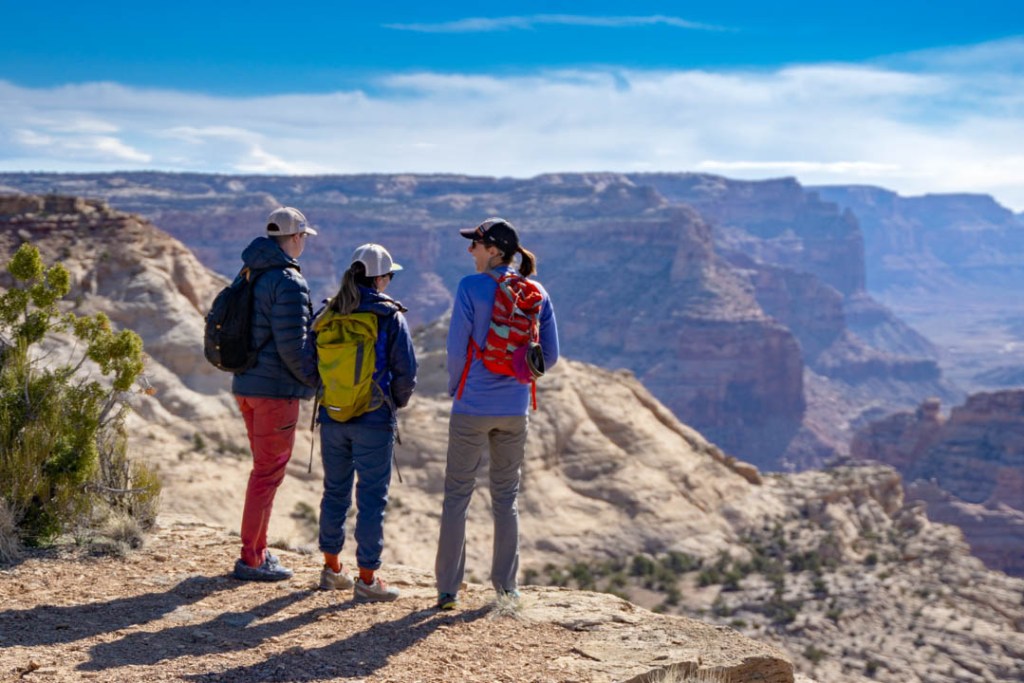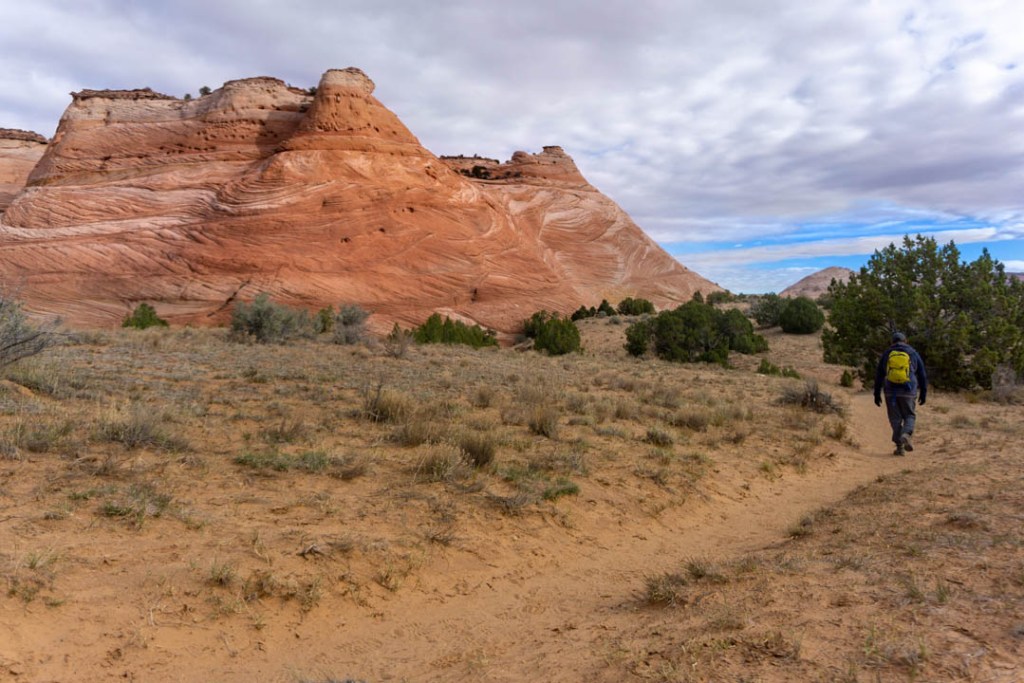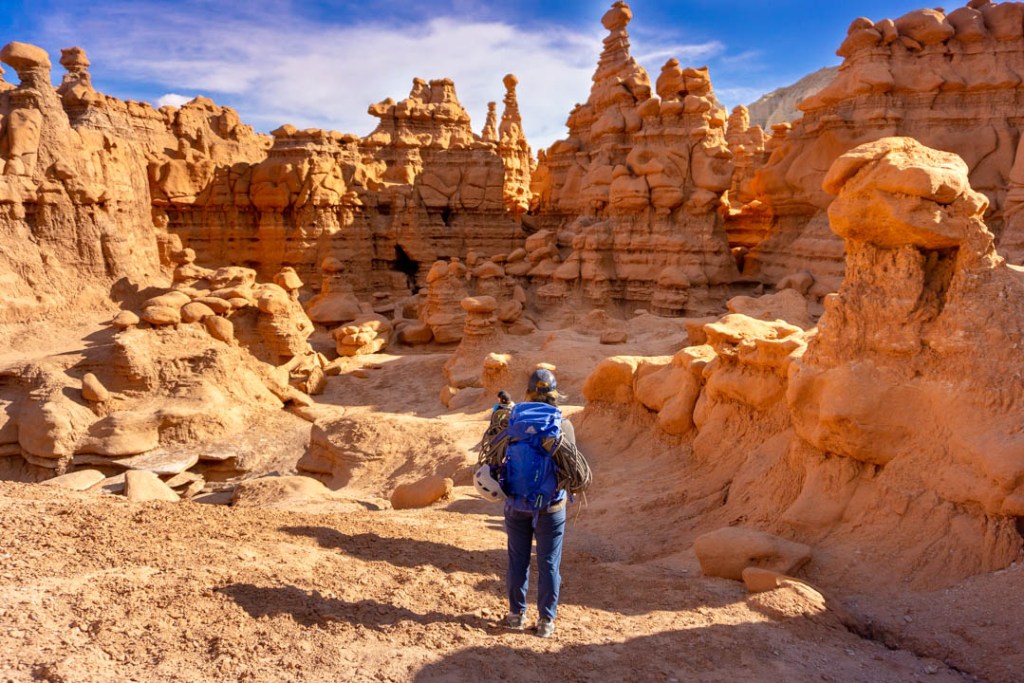The desert creates a sense of awe with its gravity-defying rock formations, ancient cultural artifacts and endless expanse of life living on the edge. However, the desert can also be an unforgiving place.
Many uninitiated visitors find themselves in a hostile environment caked in dust and dirt, and filled with challenge. I sat down with three experts to get the inside scoop on how to have a successful desert adventure. Here’s a look at how to experience this environment like a pro.
Meet the Experts
Aaron Mike is a climbing guide and the owner of Pangea Mountain Guides, a Tuscon-based climbing guide company. As a Diné (Navajo) native, he holds the desert in the highest regard. When he’s not climbing, he’s working with Natives Outdoors, local agencies and conservation groups to help protect his desert home.
Sirena Rana Dufault is the founder of Trails Inspire, a consulting company in Tucson, Arizona, that specializes in writing, photography, public speaking and trail design specifically for the desert. She discovered desert hiking and trekking after being hit by a car and used the activity to heal mentally and physically.
Brian Jump is the director of multiday tour programs for Arizona Outback Adventures, which offers a wide variety of desert tours across the American Southwest. Jump has been in the desert guiding business for over 21 years and spends more than 250 days a year guiding backpackers, kayakers and bikers through the desert in Arizona.
Helpful Know-How for Every Desert Adventurer
Before You Go:
Plan to Beat the Heat
If you’re planning a desert trip in the summer, you’ll want to be prepared for scorching conditions. Opt to recreate in the evenings or early in the morning to avoid the heat of the day. One popular trick is to wear cotton. Although cotton is often the sworn enemy of outdoor recreation, in the desert, cotton can help keep you cool.
Rana Dufault takes the cotton shirt one step further on long hikes. “Take a long-sleeve cotton shirt, get it wet before you head out, wring it out and stuff it in a zip-top baggie,” she advises. “When you’re at you’re hottest and most miserable, pull it out and put it on.” The water evaporates off the shirt, cooling you off as if you’re wearing an air conditioner. If you want to carry something lighter, a cotton bandana is also handy.
Pack Sun Protection and Dress in Layers
When packing, consider protecting yourself beyond just sunscreen. Bring a long-sleeved hooded shirt that breathes well and offers UV protection, take a wide-brimmed sun hat, wear sunglasses or even use a reflective hiking umbrella. Lightweight pants are another way to not only protect you from the sun but from the scratchy, needle-ridden plants that call the desert home.
One thing people don’t realize about the desert is that it can be cold. In fact, 30-degree swings are quite common. At higher desert altitudes, snowfall is normal, so make sure you are prepared for all kinds of conditions. Pack plenty of warm layers, a rain layer, and even a beanie and gloves, and check the weather before you head out.

While You’re There:
Stick to the Trail
Regardless of your outdoor activity, stick to the trail and walk on durable surfaces.
Cryptobiotic soil, or small built-up spires of black soil, are an essential part of the desert ecosystem. These unassuming lumps are actually living organisms that play a vital role in erosion control. Cryptobiotic soil fields take years to develop, so be sure to stick to trails and avoid busting the crust.
Understand that the Desert is Ancient
The desert is packed full of beautiful artifacts such as arrowheads, ancient dwellings, petroglyphs, pot shards and more, reminding us that great civilizations once stood here. This landscape was once someone’s home.
“When moving through these areas, try to shift your perspective from going into it … visualizing your epic adventure and performing your best to giving back for everything you take,” explains Aaron. “Go into the desert with the utmost respect for the area. Don’t aim to conquer, but aim to be a steward.” Put simply, if you see trash, pick it up, and if people are disturbing ancient artifacts, tell them it’s not okay.
Watch the Weather
Hiking in rainy weather is dangerous in the desert, especially if you are in a canyon or wash (a ditch where water runs after the rains). Flash floods come out of nowhere and endanger hikers every year. Never hike in a slot canyon if the forecast calls for rain, and keep in mind that canyons can flood if a storm dumps moisture up-canyon, far from where you may be hiking. Be sure to check the weather where you plan to hike and give the local land manager or ranger a call to make sure conditions are safe prior to heading out.
Stay Hydrated
The desert is as dry as it is hot, making hydration vitally important. Be sure to drink more water than normal (doubling your intake is a great place to start), suggests Dufault. You also may find that your eyes and nose get irritated by the dry, dusty air. Consider packing saline solution for both your eyes and nose to prevent itchy eyes and dry nasal passages.
Don’t forget to replenish your salt intake too, as over-hydration can cause health issues such as hyponatremia, a salt deficiency that can cause further dehydration and in extreme cases, heart failure, warns Dufault. She suggests balancing your water intake with salty snacks. Dufault recommends eating a handful of salted nuts, salted trail mix, salty pub mix, or some beef jerky every hour, including lunch. Also, she mentions supplementing your electrolytes with powdered sports drinks, gels, tabs or chews. The amount depends on your exertion level and heat, but the harder you work, the more you will need.
Protect Your Hands and Feet
In the desert, almost everything has a defense mechanism. Animals are quick to bite or fight and plants often have spikes or use irritants to keep critters at bay. Always watch where you are walking and don’t stick your hands in holes. Keep an eye on kids and pets, as they may be more likely to run into unhappy critters. It’s a good idea to carry a pair of tweezers in your first-aid kit, in case of an unwanted encounter with a cactus. And if you need to use a rock to secure your tent, use your foot to kick the rock over first to avoid putting your hands in harm’s way.
Tips for Hikers
Know How to Navigate
Understanding how to navigate with a map and compass, as well as a digital GPS, is an essential skill, but there are a few navigational pointers to keep in mind. Unlike forested trails with moist soils, desert trails are easily washed out by storms or may wander down sandy washes, so a GPS device or app that can track your location is helpful. Keep in mind that U.S. Geological Survey maps of the area may not be as detailed (smaller scales aren’t available) or contain as much up-to-date information about the landscape you’re traveling in, so take mental note of your position, by noting major geological features on the horizon (taking a photo looking both forward and backwards can help you recall a major junction), recommends Jump. A GPS device can be a lifeline in the desert; just keep in mind that GPS devices often struggle to find your signal if you are deep in a narrow slot canyon. Read up as much as you can about your route description before you go, and bring a paper backup with you just in case.
Seek Shade
Know your position in relation to the sun and plan your hike accordingly. “Know when to hike,” says Jump. “You can have shade on a trail during the later hours, especially in canyons, so understand your orientation to the sun.” For example, if you aim to hike through canyons, use a topographical map and the path of the sun to determine what time of day the canyon floor will have the most shade.

Tips for Mountain Bikers
Bring on the Balance
Biking in the desert requires a recalibration of your balance techniques. “Bikers who are used to more moist soil where the tires can hook up with the ground better around corners, will initially struggle on singletrack in the desert,” explains Jump. Take the time and ride slower to get your “desert legs” and find your balance on the drier soils.
Keep Your Wheels Rollin’
A slime tire sealant is key to keeping flats at bay in the desert. It’s easy to get lots of little punctures from rocks, spiky plants and other nuisances. Jump recommends using a slime or sealant that self-heals as you ride to help keep you pedaling.
Tips for Climbers
Remember that Sound Carries
There aren’t any trees or sound-absorbing surfaces in the desert. When you’re at the crag, the rock acts like a megaphone, carrying your voices and noise across the landscape. Keep things like speakers turned off. This not only helps other climbers with vital communication needs, but it avoids disturbing nearby areas.
Stay Away from Ancient Sites
People once thrived in the cliffs of many desert climbing areas. Never climb on private property without permission, and never disturb artifacts, buildings and artwork you find hidden in desert cliffs.
Respect Closures
Many birds, particularly raptors, nest high in the sandstone cliffs along favorite climbing routes. Each year, certain climbing areas close so birds can nest in peace. Respect those closures. They are in place to protect the wildlife of the area. If you find a nest in an open area, let others know by posting it to Mountain Project so the birds can raise their young.
Don’t Climb After it Rains
Never climb wet sandstone, warns Mike. Sandstone is like a sponge, and when it’s wet holds and protection can pull, leading to fatal accidents. If the ground at the base of the climb is damp or the wall visibly has wet streaks, stay away. Remember, just because the sun is out doesn’t mean the climb is dry.

Tips for Campers
Only Camp in Established Sites
One of the big draws of the desert, especially in the American Southwest, is the vast supply of free, dispersed camping. When selecting a site, first make sure you are on land that allows camping. Use a map to check the area you are traveling in. Keep in mind that in some areas ranchers own huge swaths of land, and others are Native American reservations. If you aren’t sure, call the nearest ranger station and ask about dispersed camping in your area.
Next, make sure that it has been previously established. Signs of established campsites may include a fire ring and an obvious pullout. Jump recommends pitching your tent on durable surfaces, such as slick rock or, if the weather is dry, in a wash to avoid damaging the landscape.
Where’s the Water?
In the desert, water is necessary, and what you see on a map may not be what is there in reality. Many of the streams and springs shown on maps are seasonal. When planning your trip, check with local rangers to see if a water source is running before relying on it in the wilderness. Lastly, understand the water regulations where you are traveling and plan accordingly (plan caches or water supply drops, don’t camp near isolated water sources, etc.). Check with local rangers and land managers for any special regulations in the area you plan to visit. You don’t want to take water from the animals that rely on an intermittent source for survival.
Is a Fire Necessary?
Campfires provide ambiance, but they also produce permanent scars on the landscape. If you’re backpacking, consider forgoing the fire unless you need it for survival, advises Dufault. At drive-up campsites, don’t have a fire if it’s windy. Embers quickly get carried away in harsh desert winds and cause wildfires. Source your wood from washes and ensure the wood is dead. Many desert plants only come to life with a big storm and can appear dead although they’re still living.
